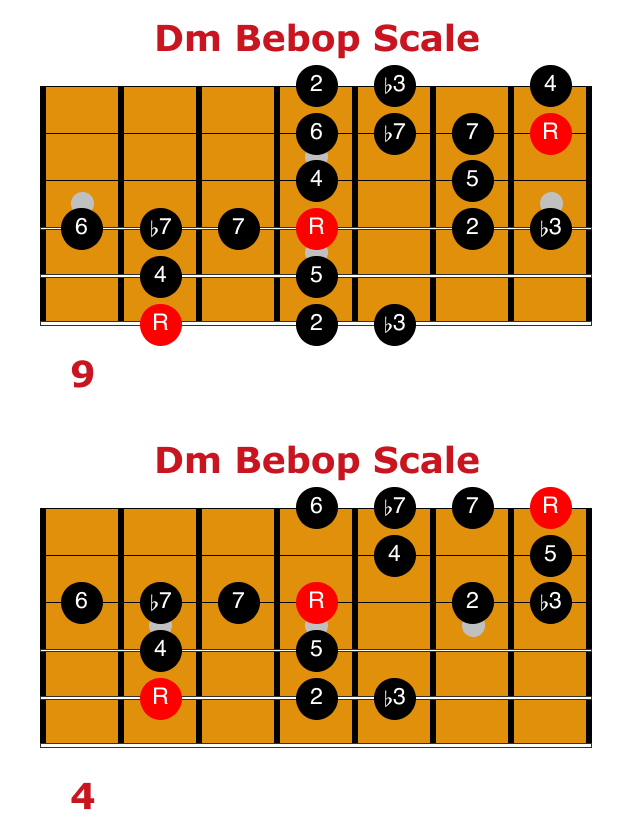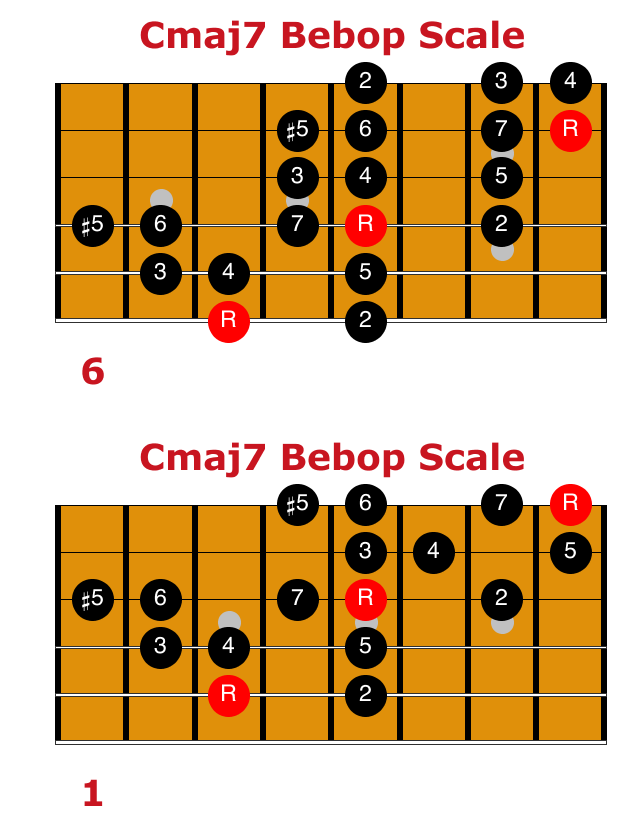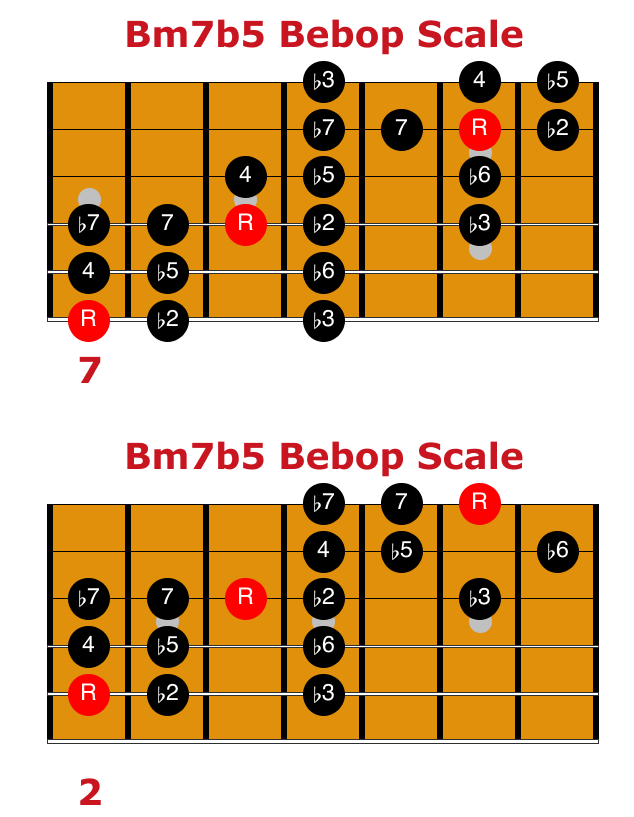Jazz Guitar Scales Essential Guide
Welcome to the jazz guitar scale essential guide, great to have you here!
Before you start, here are some pointers on how to practice these scales from a technical and soloing perspective.
Here are the four directions to practice these scales with a metronome as you work them in 12 keys.
- All up – 6th string to 1st only.
- All down – 1st string to 6th only.
- 1 up 1 down – Up G, down Ab for example.
- 1 down 1 up – Down G, up Ab for example.
As well, here are ways to practice soloing with these scales in your studies.
- Solo over 1 chord in 1 key at a time, say Gm7 with Gm bebop.
- Solo over 1 chord in 12 keys, so m7 chords in 12 keys with minor bebop.
- Solo over 2-5’s so Gm7-C7 with related bebop scales.
- Work 2-5-‘s in 12 keys.
- Add in the Imaj7, so Gm7-C7-Fmaj7.
- Work 2-5-1’s in 12 keys.
- Repeat with minor ii-V-I progressions.
- Start with just m7b5 then just 7alt.
- Work m7b5-7alt together in 1 key, then all 12.
- Work iim7b5-V7alt-Im7 in 1 key, the all 12.
Now that you’re armed with practice tools, time to get these scales into your hands, ears, and onto the fretboard.
Minor Bebop Scale – m7 Chords
The first scale that you learn in this jazz guitar scales guide is the minor bebop scale.
This scale is commonly used over the iim7 and Im7 chords in both iim7-V7-Imaj7 and iim7b5-V7alt-Im7 progressions.
The minor bebop scale is built by adding a major 7 passing tone to the Dorian mode.
When doing so, you get the intervals:
R-2-b3-4-5-6-b7-7-R
As you can see, this scale has the m7 arpeggio, 1-b3-5-b7, 3 color notes, 2-4-6, and the 7 passing note.
Here are examples of chords that work with the minor bebop scale.
- minor
- m7
- m6
- m9
- m6/9
- m11
Now that you know how to build and use the minor bebop scale, here are tips on how to practice this scale to get the most out of it in the woodshed.
- Learn 1 shape from memory, work in 12 keys.
- Solo over a m7 backing track with that scale shape.
- Sing along for added benefit.
- Repeat with 2nd scale shape.
- Mix both scale shapes together in your m7 soloing.
And, here’s the fun part, grab your guitar and get this scale under your fingers!
Note: There’s a shift halfway up this scale. To make that shift smooth, use your index finger on the lowest and middle root notes.

Dominant Bebop Scale – 7th Chords
The next scale that you learn in this jazz guitar scales guide is the dominant bebop scale.
This scale is commonly used over 7th chords in both iim7-V7-Imaj7 and jazz blues progressions, for example.
The dominant bebop scale is built by adding a major 7 passing tone to the Mixolydian mode.
When doing so, you get the intervals:
R-2-3-4-5-6-b7-7-R
As you can see, this scale has the 7th arpeggio, 1-3-5-b7, 3 color notes, 2-4-6, and the 7 passing note.
Here are examples of chords that work with the dominant bebop scale.
- 7th
- 9th
- 13th
- 7sus4
Now that you know how to build and use the dominant bebop scale, here are tips on how to practice this scale to get the most out of it in the woodshed.
- Learn 1 shape from memory, work in 12 keys.
- Solo over a 7th backing track with that scale shape.
- Sing along for added benefit.
- Repeat with 2nd scale shape.
- Mix both scale shapes together in your 7th soloing.
And, here’s the fun part, grab your guitar and get this scale under your fingers!
Note: There’s a shift halfway up this scale. To make that shift smooth, use your middle finger on the lowest and middle root notes on the 6th string shape. Then use your middle then index on the lowest two roots from the 5th string.

Major Bebop Scale – maj7 Chords
The next scale that you learn in this jazz guitar scales guide is the major bebop scale.
This scale is commonly used over maj7th chords in the iim7-V7-Imaj7 progression.
The major bebop scale is built by adding a #5 passing tone to the major scale.
When doing so, you get the intervals:
R-2-3-4-5-#5-6-7-R
As you can see, this scale has the maj7th arpeggio, 1-3-5-7, 3 color notes, 2-4-6, and the #5 passing note.
Here are examples of chords that work with the major bebop scale.
- major
- maj7
- 6th
- maj9
- 6/9
- maj7sus4
Now that you know how to build and use the major bebop scale, here are tips on how to practice this scale to get the most out of it in the woodshed.
- Learn 1 shape from memory, work in 12 keys.
- Solo over a maj7th backing track with that scale shape.
- Sing along for added benefit.
- Repeat with 2nd scale shape.
- Mix both scale shapes together in your maj7th soloing.
And, here’s the fun part, grab your guitar and get this scale under your fingers!
Note: There’s a shift halfway up this scale. To make that shift smooth, use your middle finger on the lowest and middle root notes on the 6th string shape. Then use your middle then index on the lowest two roots from the 5th string.

Locrian Bebop Scale – m7b5 Chords
The next scale that you learn in this jazz guitar scales guide is the Locrian bebop scale.
This scale is commonly used over m7b5 chords in the iim7b5-V7alt-Im7 progression.
The Locrian bebop scale is built by adding a major 7 passing tone to the Locrian mode.
When doing so, you get the intervals:
R-b2-b3-4-b5-b6-b7-7-R
As you can see, this scale has the m7b5 arpeggio, 1-b3-b5-b7, 3 color notes, bb2-4-6, and the 7 passing note.
Here are examples of chords that work with the Locrian bebop scale.
- m7b5
- m11b5
Now that you know how to build and use the Locrian bebop scale, here are tips on how to practice this scale to get the most out of it in the woodshed.
- Learn 1 shape from memory, work in 12 keys.
- Solo over a m7b5 backing track with that scale shape.
- Sing along for added benefit.
- Repeat with 2nd scale shape.
- Mix both scale shapes together in your m7b5 soloing.
And, here’s the fun part, grab your guitar and get this scale under your fingers!
Note: There’s a shift halfway up this scale. To make that shift smooth, use your index finger on the lowest and middle root notes.

Altered Bebop Scale – 7alt Chords
The last scale that you learn in this jazz guitar scales guide is the altered bebop scale.
This scale is commonly used over 7alt chords in the iim7b5-V7alt-Im7 progression.
The altered bebop scale is built by adding a major 7 passing tone to the Phrygian dominant mode.
When doing so, you get the intervals:
R-b2-3-4-5-b6-b7-7-R
As you can see, this scale has the 7th arpeggio, 1-3-5-b7, 3 color notes, b2-4-b6, and the 7 passing note.
Here are examples of chords that work with the altered bebop scale.
- 7b9
- 7#9
- 7b5
- 7#5
- 7alt
Now that you know how to build and use the altered bebop scale, here are tips on how to practice this scale to get the most out of it in the woodshed.
- Learn 1 shape from memory, work in 12 keys.
- Solo over a 7alt backing track with that scale shape.
- Sing along for added benefit.
- Repeat with 2nd scale shape.
- Mix both scale shapes together in your 7alt soloing.
And, here’s the fun part, grab your guitar and get this scale under your fingers!
Note: There’s a shift halfway up this scale. To make that shift smooth, use your middle finger on the lowest and middle root notes on the 6th string shape. Then use your middle then index on the lowest two roots from the 5th string.

